
views
X
Trustworthy Source
Mayo Clinic
Educational website from one of the world's leading hospitals
Go to source
The most common type of vertigo, benign paroxysmal positional vertigo, often has no clear cause.[2]
X
Trustworthy Source
Mayo Clinic
Educational website from one of the world's leading hospitals
Go to source
If you have vertigo, you likely want to feel better fast. Fortunately, you may be able to relieve your vertigo using natural treatments. However, see your doctor if this is your first episode of vertigo, your vertigo keeps coming back, or you may need to treat an underlying medical condition. Additionally, check with your doctor before using natural treatments.
Using Verified Home Remedies
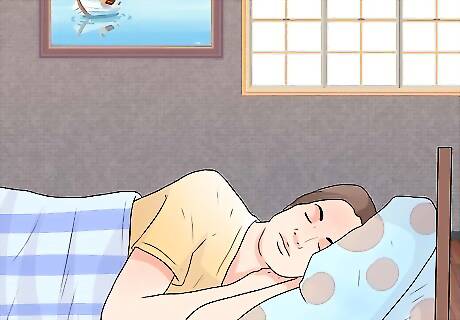
Rest to help you recover. Get some rest during and after your attacks. Make sure you are resting as much as possible. While it is not always easy to find time out from your busy life, getting rest and relaxation can minimize the effects of vertigo. If you feel dizzy at any point, sit or lie down immediately. Sudden movement—and sometimes any movement—can worsen the sensation of vertigo. Avoid bright lights if possible, such as those from a television, overhead lighting, or your phone, as these can aggravate your vertigo. Avoid driving a car or operating any heavy machinery. Additionally, avoid environments with flashing lights, such as video games, some movies, or dance clubs.

Drink water to prevent dehydration. Vertigo or dizziness may be caused by dehydration as it decreases the blood volume and thereby the oxygen supply to your brain. In addition, the balance system in your inner ear uses fluids to transmit information about fluid levels in your body, which is in turn interpreted by the brain to produce a sense of balance. Rehydrating frequently, especially while exercising or suffering from diarrhea, can help minimize your dizziness. Your body needs 2.2–3 liters (0.6–0.8 US gal) of liquids a day. While all liquids fall under this umbrella, water is best. It has no empty calories, no caffeine, and isn't a diuretic, like some sodas, coffees, teas, and juices are.

Take over-the-counter motion-sickness medication. Taking motion sickness medicine, such as meclizine (Bonine) or dimenhydrinate (Original Formula Dramamine), which are available over-the-counter, can relieve dizziness. Follow the directions on the back of the box for dosing or talk to your doctor to get a specialized dosage recommendation. Then, take the medication exactly as directed. Check the back of the box for the active ingredient in the medication. You should consult your doctor before self-medicating for dizziness. They will be able to tell you what medication and what dosage is best for you.

Try ginger to help manage your vertigo symptoms. Chinese sailors used ginger for centuries to combat motion sickness, and now it's widely used to fight dizziness. Ginger can be consumed in food, in your tea, or you can even munch on it raw. If you don’t like the taste of ginger, you can also take it in capsule form. Clinical research has demonstrated that ginger is effective at combatting vertigo, but the reasons are still not clear. A study from the 1980s found that it might have some effect on the inner ear, which plays an important role in your sense of balance. Ginger can also soothe nausea, a common side effect of vertigo. Add a piece of raw ginger to boiling water to make ginger tea. Up to 3 small roots per day is acceptable, but usually 1 root or 1 tablespoon (15 mL) of juice is enough for the body.
Doing Exercises
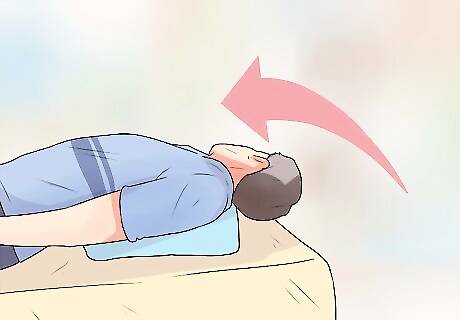
Do the Epley maneuver to find your balance. Also known as the canalith repositioning procedure, the Epley maneuver helps to reset the balance mechanisms in the inner ear by repositioning the particles in the vestibular organs (the balance organs). These particles can get trapped in the inner ear, which causes dizziness. You can do this at home, although it should be demonstrated by your healthcare professional before you undertake it yourself as it does require some quick movements. Note that the Epley maneuver is effective in 90% of cases, but it can cause an intensification of vertigo initially. Consider asking a friend or family member to act as your assistant so that your head lands in the right spot each time. Here's how to do it: Sit on a bed. Turn your head 45° by looking to the right. Lie back quickly and place your shoulders on the pillow. Your head will be lower than your shoulders and you will still be looking 45° to the right. Remain in this position for 30 seconds. After the 30 seconds, turn your head 90° to the left. Do not raise your head during this movement. Remain in this position for 30 seconds. Turn your entire body and your head another 90° to the left and wait for 30 seconds. At this point, you should be lying on your left side. Your head should still be lower than your shoulders. Repeat this exercise 3 times daily for best results. Find relief from post-surgery vertigo attacks. "After having mastoid ear surgery, I suffered horrible vertigo spells that left me dizzy and nauseated. This guide recommended a honey and apple cider vinegar drink that tastes great and really calms my nausea. It's been a lifesaver for getting through those debilitating dizzy spells." - Renee K. Recognize vertigo attack symptoms in a loved one. "When my 75-year-old father started having intermittent vertigo attacks, reading this article helped me identify all his symptoms — dizziness, vomiting, and loss of balance. Knowing exactly what was happening let me care for him properly during spells and get his doctor accurate details." - Ravi K. Overcome age barriers to treat vertigo. "At 75, I struggled to do the Epley and Half Somersault exercises to reposition the inner ear crystals, causing my vertigo. But this guide explained just why those awkward movements are so critical for people like me. It gave me the motivation I needed to push past frustration and keep trying the exercises despite my age. I've finally seen improvement!" - Barbara K. Validate effective home remedies. "For years, I've drank ginger lemon tea when vertigo episodes strike. I was relieved when this article specifically recommended that home remedy, along with helpful info on diet, sleep, and stress reduction. My instincts were right — simple lifestyle changes make a difference!" - Aida G. Did you know that wikiHow has collected over 365,000 reader stories since it started in 2005? We’d love to hear from you! Share your story here.
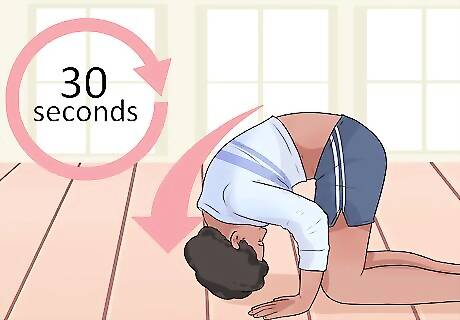
Try the Half Somersault maneuver to feel less dizzy. Also known as the Foster maneuver, this is another good exercise and, unlike the Epley maneuver, does not require an assistant. One study found that patients who did both exercises experienced symptomatic relief but reported less dizziness and fewer complications when doing just the Half Somersault. You will likely need to do this exercise multiple times before you experience some relief. Follow this procedure: Get down on your knees and look up at the ceiling for a few seconds. Touch the floor with your head. Tuck your chin slightly towards your chest so your head moves toward your knees. Wait for the vertigo to subside (about 30 seconds). Turn your head in the direction of your affected ear (i.e., if you feel dizzy on your left side, turn your head so that it faces your left elbow). Keep your head in this position for 30 seconds. Then, raise your head so it is level with your back while you're on all fours; your spine should look like a straight line. Keep your head at that 45° angle. Stay 30 seconds in this position. Raise your head and back so that you are upright again, but keep your head tilted to the shoulder of the side you're working on. Take your time to stand up. Rest 15 minutes before repeating a second time or doing the other side.
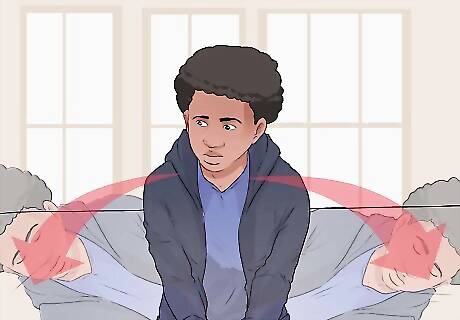
Practice the Brandt Daroff regimen to help relieve your vertigo. These exercises involve the head and the muscles of the neck and can be performed at home without a physician's supervision. The repeated head movements of this regimen help you habituate to the experience of vertigo by dispersing the particles in the vestibular organs in the inner ear. Perform the following movements: Begin in an upright, seated position. Quickly lie down on one side with your nose pointed up at about a 45° angle. Stay in this position for about 30 seconds (or until the vertigo is gone). Then, get back in your seated position. Do this exercise on the other side. This exercise is most effective if you do multiple repetitions at least twice daily.

Try the "eye patch" exercise each morning. As soon as you wake up, keep one hand on any one eye and close it for 20 seconds while using the other eye to look out into the distance and focus on a point far away. Then switch the hand to the other eye and let the previous eye repeat the same effort. Do this about 10 times every day upon waking. The relationship between your eye muscles and your inner ears helps you stay balanced most of the time while your head is moving. However, dislodged particles in your inner ear can make you think you're moving when you're not. This causes the eyes to mistakenly move, making it look the room is spinning. Over time, doing exercises to strengthen your eye muscles will reduce the sensitivity of the inner ear canal, which in turn will lead to reduced frequency and intensity of vertigo.

Maintain a fixed gaze to fight dizziness. Staring at one point can help you overcome dizziness. It helps improve your vision and maintain focus while your head is moving. Dancers, when doing turns, are told to "spot." This is where they keep their eyes focused on one spot for as long as they can as their body rotates. This lets them spin without becoming dizzy and is the same principle that can be applied here. Focus on a spot straight ahead during your dizziness spell and the dizziness will likely subside. Here's how to practice stabilizing your gaze: Look straight ahead and focus on something (like a small colored square or button) held at eye level in front of you. Move your head from side to side, all the while maintaining your gaze on the target. Slowly increase the speed of your head movement. Make sure your target is still in focus and is not just a blur. If you start to feel too dizzy, slow down. Continue moving your head for up to 1 minute because the brain needs this time to adjust. Keep working on it until you can do this exercise 3 to 5 times every day. Build up gradually to repeat 3 to 5 times a day. You can also try this exercise with an up-and-down, or nodding, movement.
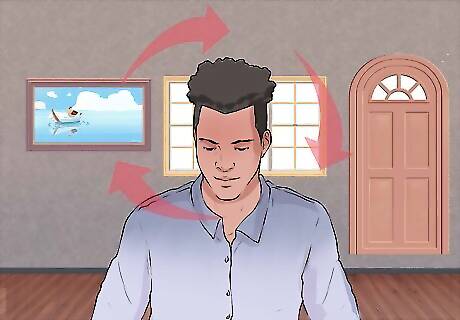
Do simple head rotations to relieve muscle spasms. While sitting upright on a chair, bring your head down such that your chin touches your chest, and then start rotating your head clockwise, slowly but firmly, 3 times. This may release the spasm in your muscles and reduce vertigo. Repeat it 3 times going the opposite way, counter-clockwise. Pause for a break of 45 seconds between each direction of rotation. Then, turn your head towards either side while using the palm of your hand of that side to resist that movement and stretch the neck muscles.
Making Lifestyle Changes

Avoid substances that affect the circulation to your brain. Take care to avoid substances that alter the blood supply to your brain, which include caffeine, chocolate, alcohol, and various illegal drugs. These substances can cause nerves to swell and blood vessels to constrict. This can increase sensations of dizziness. If you do consume any of these, make sure you're not doing so on an empty stomach as the effects will be worsened.
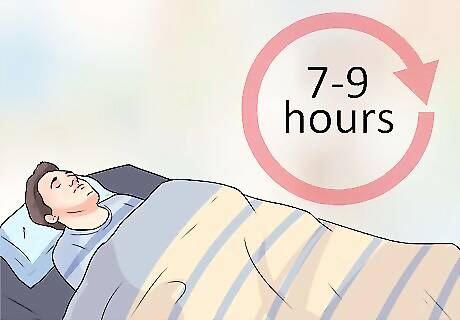
Get enough sleep so you're well-rested. Absence of good, sound sleep can cause or aggravate vertigo. Try to get a full night's sleep starting at about the same time every night and waking around the same time each morning. Though everyone's sleep needs are different, most adults do best with about 7 to 9 hours of sleep. Children and teens may require more sleep. If you're working on trying to fall into a more consistent sleep pattern, wait until bedtime to sleep and avoid napping during the day. Naps are a great way to recharge your batteries when you have a stable sleep schedule, but they are counter-productive when trying to change sleeping habits.

Maintain a healthy diet. The Anti-Inflammatory Diet can be particularly useful to reduce inflammation, including disorders that end in “itis”. This diet also provides all the essential vitamins and minerals, particularly if you eat a variety of foods. The general principles of the Anti-Inflammatory diet (similar to the Mediterranean diet) include the following: Keep your food as close to its original or natural form as possible. This means that you should try to limit any processed or prepared foods and cook from scratch as frequently as you can. Reduce your intake of salt and sugar by limiting your consumption of junk foods and processed snacks, such as chips, cookies, cakes, and crackers. Use olive oil as your main cooking oil since it's full of healthy fats. Avoid fried or fatty foods, like onion rings, French fries, hamburgers, and hotdogs. Limit red meats and eat only skinless poultry or fish. Increase the amount of fish in your diet. Excellent sources of omega 3 fatty acids include salmon, tuna, sardines, and anchovies. Increase all fruits, berries, and vegetables. Include brightly colored berries and fruits and leafy greens, such as Swiss chard, spinach, beet and mustard greens, and kale. You should also try to include broccoli, cauliflower, and Brussels sprouts, which have anti-inflammatory and cancer-preventing properties. Include garlic and onions in your diet as these contain anti-inflammatory and immune-boosting substances.

Exercise regularly for good overall health and stress management. Everyone's exercise needs are different. However, the Centers for Disease Control (CDC) recommend that adults get at least 2 and a half hours of moderate-intensity aerobic exercise (like brisk walking) per week, along with 2 days of moderate strength-training exercise (like weight lifting). While this exercise may not cure your vertigo specifically, it will contribute to your overall health and well-being, much like the dietary changes suggested above.
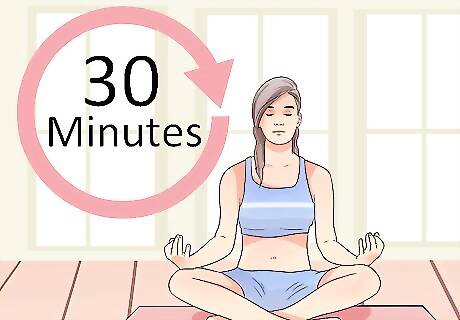
Do yoga to relieve your stress. Yoga is good for vertigo as it helps release spasms in your neck muscles and keep them more flexible and supple. In the long term, regular yoga for at least 30 minutes a day will prevent re-occurrence of vertigo and ensure better stress tolerance. Yoga also helps with balance and helps cultivate your ability to concentrate and focus. Yoga is great for the mind and body. Your stress levels will be lower, your muscles will be more relaxed, and you may experience fewer episodes of vertigo to boot. If you are experiencing vertigo, however, you should let your yoga instructor know before class so that they can offer you modifications for poses as needed.
Trying Unverified Home Remedies

Eat more almonds. Almonds are one of the best nuts to eat, and are rich sources of vitamins A, B, and E. Consuming up to 5 almonds a day, every day—whether eaten directly, crushed or grated, or even mixed with food—has been found to be beneficial for vertigo. The exact mechanism isn’t known, but it is suggested that the vitamin B and E content in almonds helps combat free radicals that cause vertigo. Almonds may also be soaked in water for an hour before being consumed.

Use lemon in your meals. Adding a lemon peel or a drop or 2 of lemon peel extract to your food every day not only enhances the taste of the food, but also provides a good source of antioxidants and trace minerals that help with vertigo. Lemons are rich in vitamin C, which works by combating free radicals that cause vertigo. You can also mix it with apple juice and ginger if you'd like.

Use apple cider and honey. Honey has been known for its curative properties for centuries. Add 2 parts honey to 1 part apple cider. Consume 1 tablespoon (15 mL) of this mixture 2 to 3 times a day. This may prevent vertigo from developing or treat it if you are suffering from it, since honey and apple cider facilitate blood flow to the brain.

Make a nausea-fighting drink. For vertigo that is associated with nausea and vomiting, mix together 1 glass of warm water with 4 crushed black peppers, 7 to 8 drops of lemon juice, and a pinch of salt. Stir well before consuming. This is to be used only to relieve the acute episode of vertigo you're experiencing and not for regular consumption every day. It may calm the wave of nausea occurring with your vertigo. The acidity of lemon and salt will calm down your agitated stomach.

Try amla, or Indian Gooseberry. This plant is rich in vitamin C, vitamin A, antioxidants, flavonoids, and pectin. All of these keep your body nourished and revitalized. The vitamin C present in amla neutralizes the free radicals that are released in the body and helps your body combat vertigo. This is an Ayurvedic treatment, which is a form of holistic medicine from India. Amla can be had raw, 1 to 2 a day. It can also be consumed as a juice, tea, or blended or pureed into a paste or a juice –1 glass (about 200 ml) once a day, preferably in the mornings. You can also marinate amla to give it a pickle-like consistency. Pickled amla can be consumed as an accompaniment to food. About 2 tablespoons of this would suffice for the day’s requirements.
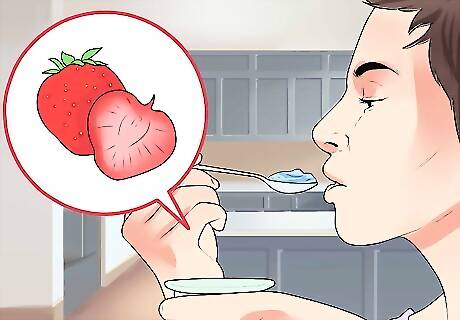
Try yogurt and strawberries. A mixture of yogurt or curds with freshly cut strawberries also may help treat an episode of vertigo almost instantaneously. This can be consumed on a daily basis as well. Make yourself a small bowl of yogurt (about 120 g) with about 5 or 6 freshly cut strawberries at the very first sign of any dizziness. However, if you suffer from migraines, you may want to avoid yogurt as it contains tyramine, a migraine exacerbator. Flavonoids are found in all different kinds of berries, like strawberries, raspberries, gooseberries, and cranberries. They are rich sources of antioxidants, which makes them very effective in helping with vertigo. In addition, the vitamin C in berries is also beneficial in treating vertigo. You could also add some chopped almonds to the yogurt and berries for an added boost.
When to Seek Medical Care
See your doctor if this is your first experience of vertigo. If you’ve never had vertigo before, you need to get prompt treatment to make sure you’re okay. Your doctor can make sure that your symptoms are vertigo and figure out what’s causing it. Go to your doctor’s office, an urgent care center, or the emergency room to get checked out. Try not to worry, because you’re probably okay. However, it’s best to see your doctor to make sure you don’t need additional treatment.
Get emergency medical care if you have other severe symptoms. In rare cases, vertigo can be a sign of a medical emergency, such as a stroke. Call emergency services or have someone take you to the nearest emergency room if you develop new or severe vertigo along with other symptoms, such as: A sudden headache Chest pain Difficulty breathing Numbness, weakness, or paralysis in your arms, legs, or face Sudden changes in your vision or hearing A rapid or irregular heartbeat Confusion or difficulty speaking Fainting or seizures Difficulty walking or loss of coordination Vomiting that won’t stop
Talk to your doctor if your vertigo doesn’t improve. With treatment, your vertigo symptoms should be manageable. However, it’s possible that your episodes will continue to occur. This might require additional treatment. Visit your doctor to find out what you can do to improve your condition. Tell your doctor about the treatments you’ve already tried to treat your condition.

Work with your doctor to find the underlying cause of your vertigo. Sometimes vertigo is caused by a medical condition, so it’s important to get a proper diagnosis from your doctor. They’ll rule out potential causes for vertigo to make sure you’re getting the right treatment. Visit your doctor to get a full medical workup to find the underlying cause of recurring vertigo. Your doctor may offer you treatment for your medical condition. Keep in mind that vertigo is a symptom, not an illness. That means you likely have a condition that’s causing it. While you might not need to treat your underlying condition, it’s best to be sure.
Check with your doctor before using natural treatments. While herbal remedies and natural treatments are generally safe, they aren’t right for everyone. They can interact with medications you’re taking or worsen certain medical conditions. Talk to your doctor before you use any natural treatments to make sure they’re right for you. Tell your doctor which treatments you plan to take and that you’re hoping to treat your vertigo. Additionally, remind them of the medications and supplements you’re already taking.




















Comments
0 comment